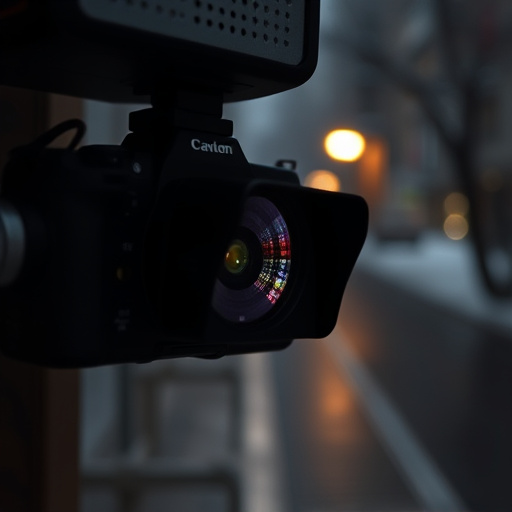Detecting Wireless Night Vision signals indoors requires specialized tools like direction finding gear and RF spectrum analyzers to locate hidden cameras operating on 2.4 GHz or 5 GHz bands. Regular updates to these devices are crucial. Using RF detectors and scrutinizing visual clues offer enhanced security against unauthorized surveillance, with advanced cameras providing real-time signal interference analysis for complex indoor settings.
Uncover hidden monitoring device signals with our expert tips on detecting wireless night vision security cameras indoors. Learn how to navigate through hidden camera frequencies and utilize RF detectors for enhanced indoor security. Discover visual clues that might reveal covert surveillance and explore advanced techniques for signal detection. Stay informed and secure in today’s digital era.
- Detecting Wireless Night Vision Signals Indoors
- Understanding Hidden Camera Frequencies
- Using RF Detectors for Indoor Security
- Visual Clues: Uncovering Hidden Cameras
- Advanced Techniques for Signal Detection
Detecting Wireless Night Vision Signals Indoors
Detecting Wireless night vision signals indoors can be a challenging yet crucial task for security and privacy reasons. Wireless night vision security cameras, due to their wireless nature, often emit signals that are invisible to the naked eye but can be picked up by sensitive receivers. To counter this, it’s essential to invest in signal detection tools designed specifically for indoor environments. These devices use advanced technology to scan through walls, ceilings, and other obstacles to pinpoint the location of wireless night vision signals.
One effective method involves using direction finding gear that analyzes radio frequency (RF) emissions. This equipment can help you identify the direction from which the signals are emanating, allowing you to narrow down potential camera locations. Additionally, employing RF spectrum analyzers offers a deeper understanding of signal patterns and characteristics, enabling you to differentiate between legitimate devices and hidden surveillance equipment. Regularly updating your detection tools is vital, as new wireless night vision cameras come with evolving technology designed to minimize their signal signatures.
Understanding Hidden Camera Frequencies
Hidden cameras, often disguised as everyday objects, can operate on a range of frequencies to capture video footage secretly. Understanding these frequencies is key to detecting and identifying them. Many hidden cameras, especially those designed for indoor use like Wireless Night Vision Security Cameras, frequently transmit signals in the 2.4 GHz or 5 GHz bands, which are commonly used for wireless networking.
By familiarizing yourself with these frequency ranges and utilizing signal detection tools, you can enhance your ability to uncover hidden surveillance devices. This knowledge is particularly valuable when conducting thorough searches of private residences or commercial spaces to ensure privacy and security.
Using RF Detectors for Indoor Security
Wireless night vision security cameras indoors have become a popular choice for homeowners and business owners alike, offering enhanced surveillance with advanced technology. When it comes to ensuring the integrity of your indoor security system, RF (Radio Frequency) detectors play a crucial role in detecting and identifying hidden monitoring devices. These sensitive devices can pick up on wireless signals emitted by various electronic gadgets, including those used in covert camera setups.
By employing RF detectors, you can proactively search for and locate hidden cameras that may be installed without your knowledge. These detectors are particularly useful in high-security areas where the risk of unauthorized surveillance is higher. With their ability to detect a wide range of wireless signals, RF technology helps uncover clandestine monitoring devices, providing an extra layer of protection for your personal or business spaces.
Visual Clues: Uncovering Hidden Cameras
When it comes to detecting hidden monitoring devices, especially wireless night vision security cameras indoors, paying attention to visual clues can be a powerful tool. While some cameras might be disguised as everyday objects like smoke detectors or light bulbs, their unique shapes or slightly off-center placements can raise suspicions. Look for any irregularities in the field of view—for instance, a camera might be positioned at an odd angle or have a distorted image due to its placement behind a surface.
Additionally, modern wireless night vision security cameras often have visible indicators like small LED lights that glow when active. These lights may appear as persistent red dots or flicker intermittently. Examining walls, ceilings, and corners for such unusual lighting can help uncover hidden surveillance equipment. It’s also worth noting that sophisticated camera setups might be entirely invisible to the naked eye, but even in these cases, subtle visual distortions on screens or odd behavior from connected devices could suggest their presence.
Advanced Techniques for Signal Detection
In the realm of hidden monitoring device signal detection, advanced techniques are pivotal for successful identification and neutralization. One cutting-edge approach involves integrating wireless night vision security cameras indoors, which not only provide enhanced visibility but also detect unusual signals that might indicate the presence of hidden devices. These cameras employ advanced image processing algorithms to analyze video feeds in real time, identifying patterns and anomalies that could be indicative of covert listening devices or tracking software.
By combining high-resolution imaging with signal interference detection, security professionals can uncover hidden monitoring devices within complex indoor environments. This method is particularly effective for businesses and homes alike, ensuring a robust security network against unwanted surveillance. With the right setup, wireless night vision security cameras indoors serve as vigilant sentinels, safeguarding privacy and providing peace of mind in an increasingly digital world.
Uncovering hidden monitoring device signals requires a multi-faceted approach. By understanding the diverse range of frequencies and technologies employed, such as wireless night vision security cameras indoors, you can leverage tools like RF detectors and visual clues to ensure a safer environment. Combining these techniques allows for advanced signal detection, enabling you to stay one step ahead in navigating this modern surveillance landscape.
